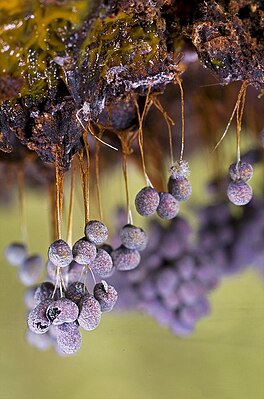Badhamia utricularis
| Badhamia utricularis | ||||||||||||
|---|---|---|---|---|---|---|---|---|---|---|---|---|

Badhamia utricularis |
||||||||||||
| Systematics | ||||||||||||
|
||||||||||||
| Scientific name | ||||||||||||
| Badhamia utricularis | ||||||||||||
| ( Bull. ) Berk. |
Badhamia utricularis is a slime mold from the Physaridae family .
features
Macroscopic properties
The fruiting bodies form numerous grape-shaped clusters that form tightly packed groups. The capsules are spherical, mostly oval but also egg or pear-shaped. They are blue to blue-gray in color. In rare cases of calcium deficiency, they are tinted deep dark blue. Sometimes the surface is metallic iridescent. The fruit bodies reach a diameter of 0.4 to 1.5 millimeters and a length of one to two millimeters. They are located on thin, thread-like to ribbon-like stems, where they usually hang. In rare cases the fructifications are serene.
The shell ( peridia ) consists of a thin skin. The surface can be wrinkled due to lime. The peridia tears up irregularly in the upper area, but is often almost completely preserved. After the spores disappear, it appears bright white. In the light passing through, meandering lines can be seen that can form an incomplete network.
The stems are straw yellow to brown in color and are quite fragile. They are 0.5 to 3 millimeters thick and 5 millimeters long, rarely longer. They are often bundled up and resemble dry grass. The stems have cross connections and divide like fibers. Sometimes there are several fruiting bodies at the tips. The common membranous base ( Hypothallus ) is ocher to brown and goes into the stems. Often it is hardly noticeable.
The spores appear black in bulk. The plasmodium is yellow to orange-yellow.
Microscopic properties
The capillitium forms a coarse-meshed network that is attached to the peridia. It consists of flat, ribbon-like tubes that are filled with soda-colored lime. The strands are 5 to 30 micrometers thick. At the connection points they are rounded off in an arc or triangularly widened.
The spores are exposed or hang together in small, easily separable clumps. They are rounded, but can also be somewhat irregular. They measure 9 to 15 micrometers in diameter. There are evenly distributed dark brown warts on the surface. These are up to a micrometer high.
Similar species
Badhamia utricularis is quite variable. It is easy to identify in typically large groups with a drooping stem. The easily separable spores with their uniform warts are characteristic microscopically. The separability can be checked by lightly pressing the cover slip. The spores of Badhamia capsulifera , B. dubia and B. versicolor adhere more closely to each other and have a clearer pattern on the side facing away from the urban center. B. populina has irregularly rounded spores.
ecology
The fruiting bodies are formed between September and April, except when there is frost. Sometimes they can be found as early as summer. The slime mold colonizes the bark or the dead wood of deciduous and coniferous trees. Often it can also be found on the Striegeligen layer mushroom ( Stereum hirsutum ); sometimes also on the yellow- stemmed oyster mushroom ( Sarcomyxa serotina ) or the large-pored Datronia ( Datronia mollis ). Associations were observed with Badhamia foliicola , Physarum nutans and Trichia contorta (var. Contorta ).
distribution
Badhamia utricularis is distributed worldwide and is found quite frequently in Central Europe.
literature
- Hermann Neubert , Wolfgang Nowotny , Karlheinz Baumann , Heidi Marx: The Myxomycetes of Germany and the neighboring Alpine region with special consideration of Austria . tape 2 . Karlheinz Baumann Verlag, Gomaringen 1995, ISBN 3-929822-01-6 .